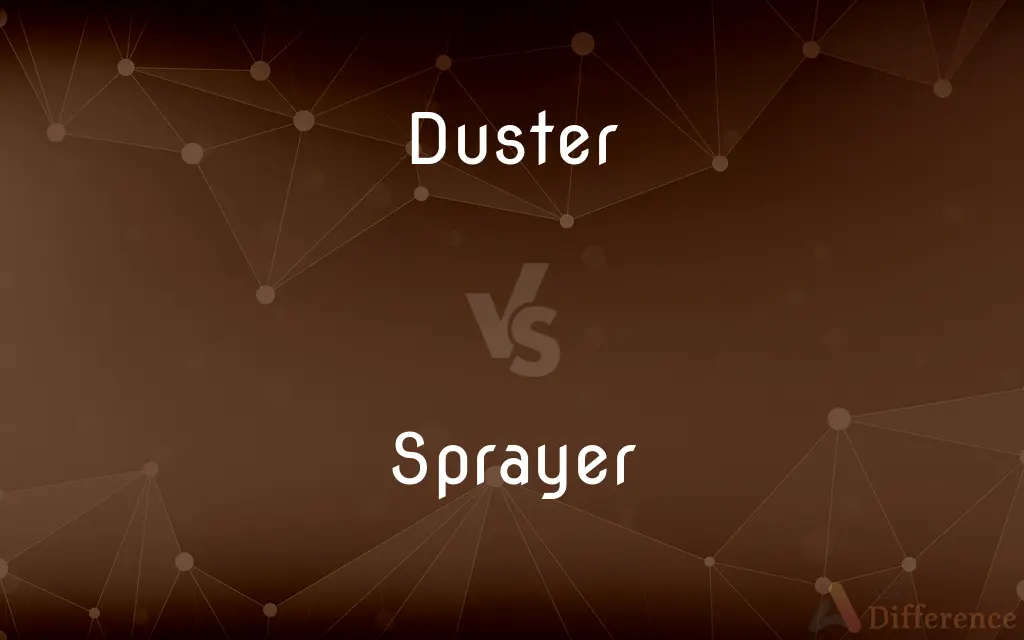Duster vs. Sprayer — What's the Difference?
By Urooj Arif & Fiza Rafique — Updated on February 28, 2024
"Duster" refers to a device or tool designed for applying dust, often pesticides or insecticides, in powder form. "Sprayer" is a device used for spraying liquids, such as water, pesticides, paint, through a nozzle to distribute them evenly over an area.

Difference Between Duster and Sprayer
Table of Contents
ADVERTISEMENT
Key Differences
A duster is specifically designed to distribute fine particles, such as dust or powder, over a targeted area. Sprayers, on the other hand, are devices that atomize liquids into fine droplets, allowing for an even coating over surfaces.
Duster is a tool commonly used in agriculture for spreading pesticide or insecticide powders on crops to protect them from pests. For example, "The farmer used a duster to apply diatomaceous earth around the plant bases." Sprayer come in various forms, including handheld, backpack, and motorized models, and are used in a wide range of applications from garden maintenance to automotive painting. An example of their use is, "She used a sprayer to apply an even coat of herbicide on the weeds."
The key difference between these two lies in the state of the material they are designed to apply: dusters handle powders, while sprayers are for liquids. This distinction is crucial for understanding their applications, as the effectiveness of certain chemicals depends on their form of application.
Both dusters and sprayers are vital in agriculture, gardening, and maintenance tasks, offering users a method to efficiently apply substances over plants, surfaces, or objects. However, the choice between a duster and a sprayer depends on the specific needs of the task, including the type of chemical being applied and the desired coverage.
Despite their different functions, both devices aim to improve the efficiency and effectiveness of applying agricultural chemicals, protective coatings, or cleaning solutions, demonstrating the importance of choosing the right tool for the job.
ADVERTISEMENT
Comparison Chart
Purpose
Applies dust or powder.
Sprays liquid solutions.
Common Uses
Spreading pesticide powders, insecticides.
Applying water, liquid pesticides, paints.
Material Form
Powder or dust.
Liquids.
Application Method
Blowing or shaking to disperse particles.
Atomizing liquids into droplets through a nozzle.
Examples
Diatomaceous earth duster for gardens.
Handheld garden sprayer for watering or herbicide application.
Compare with Definitions
Duster
A tool for applying powder.
The gardener used a duster for organic pest control.
Sprayer
Device for liquid application.
She used a sprayer to mist her indoor plants.
Duster
Designed for powder substances.
A sulfur duster helps prevent grape vine diseases.
Sprayer
Versatile liquid distribution.
A paint sprayer provides a smooth, even coat.
Duster
Agricultural tool.
Farmers use crop dusters to distribute insecticide evenly.
Sprayer
Garden maintenance tool.
The landscaper applied herbicide with a backpack sprayer.
Duster
Pest control device.
A duster is effective for applying dust pesticides in tight spaces.
Sprayer
Can be pressurized.
The pressure sprayer makes applying liquid fertilizers easier.
Duster
Manual or powered.
He filled the hand-powered duster with fungicide.
Sprayer
For cleaning and maintenance.
A sprayer filled with disinfectant cleaned the surfaces efficiently.
Duster
A device for sifting or scattering a powdered substance.
Sprayer
A sprayer is a device used to spray a liquid, where sprayers are commonly used for projection of water, weed killers, crop performance materials, pest maintenance chemicals, as well as manufacturing and production line ingredients. In agriculture, a sprayer is a piece of equipment that is used to apply herbicides, pesticides, and fertilizers on agricultural crops.
Sprayer
Water or other liquid moving in a mass of dispersed droplets, as from a wave.
Sprayer
A device, machine or vehicle used for spraying, where sprayers are commonly used for projection of water, weed killers, crop performance materials, pest maintenance chemicals, as well as manufacturing and production line ingredients.
Common Curiosities
Can the same chemicals be used in both dusters and sprayers if they are in different forms?
Yes, some chemicals are available in both liquid and powder forms, allowing them to be used in either dusters or sprayers depending on the desired application method.
Are sprayers more versatile than dusters?
Sprayers can be considered more versatile due to their ability to distribute a wide range of liquid products in various settings, from agriculture to automotive painting.
Are there safety concerns unique to using dusters or sprayers?
Both require safety precautions, especially when applying pesticides or toxic substances. Proper protective gear should be worn, and manufacturer instructions followed to ensure safe use.
Do dusters and sprayers affect the environment differently?
The impact on the environment depends more on the substances being applied than on the devices themselves. However, the precision of application can minimize environmental impact.
How do I choose between a duster and a sprayer for pest control?
The choice depends on the form of pesticide (liquid or powder) you intend to use and the specific needs of the application area.
Can a duster be used for liquid applications?
No, dusters are specifically designed for distributing powders and cannot efficiently handle liquids.
How does the effectiveness of dusters compare to sprayers for agricultural applications?
Effectiveness depends on the target pest and the crop. Some situations require the precise application of powder, while others benefit from liquid coverage. Each has its place in an integrated pest management strategy.
Can dusters and sprayers be used in indoor settings?
Yes, but with caution regarding ventilation, the nature of the substance being applied, and potential damage or stains to indoor surfaces.
What maintenance is required for dusters and sprayers?
Regular cleaning and inspection are essential to prevent clogging and ensure efficient operation. Follow the manufacturer’s maintenance guidelines.
Are there environmentally friendly options for dusters and sprayers?
Yes, there are models designed to minimize waste and optimize the application, reducing the amount of chemical needed and its impact on the environment.
Share Your Discovery

Previous Comparison
Cage vs. Mew
Next Comparison
Overrate vs. OverestimateAuthor Spotlight
Written by
Urooj ArifUrooj is a skilled content writer at Ask Difference, known for her exceptional ability to simplify complex topics into engaging and informative content. With a passion for research and a flair for clear, concise writing, she consistently delivers articles that resonate with our diverse audience.
Co-written by
Fiza RafiqueFiza Rafique is a skilled content writer at AskDifference.com, where she meticulously refines and enhances written pieces. Drawing from her vast editorial expertise, Fiza ensures clarity, accuracy, and precision in every article. Passionate about language, she continually seeks to elevate the quality of content for readers worldwide.















































